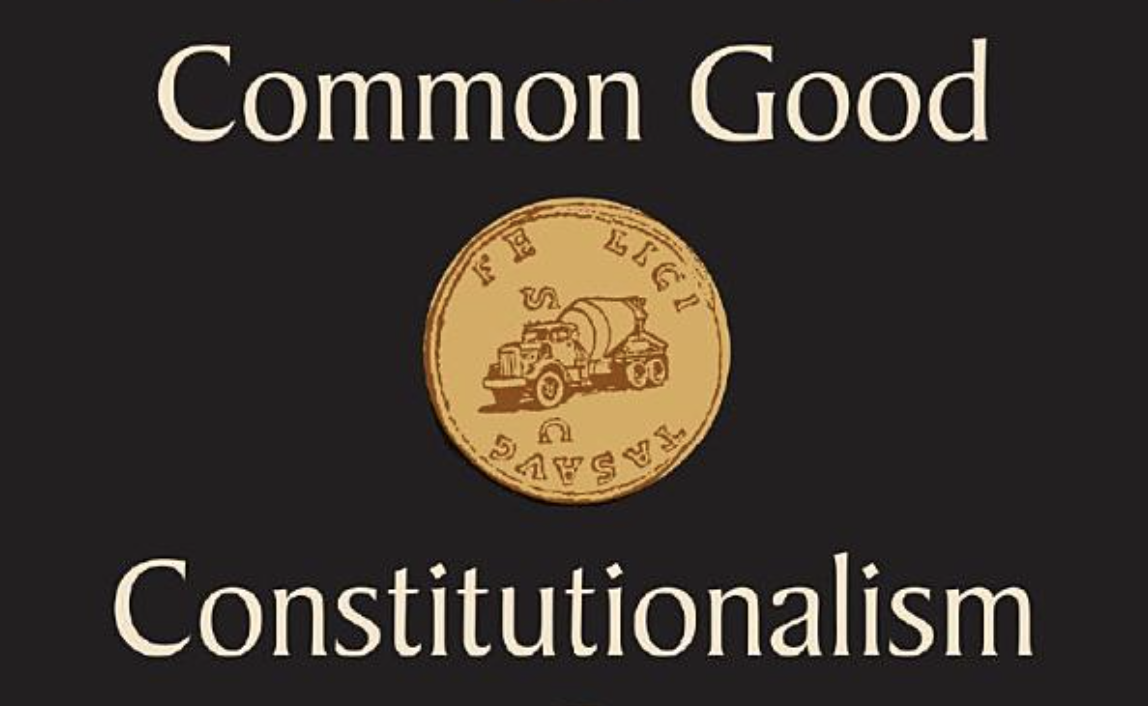
Adrian Vermeule’s Common Good Constitutionalism is really two books in one. The first is an exposition and defense of the classical view of what law is—an ordinance of right reason for the common good, directed toward the objective of human flourishing. The second, by contrast, is a treatment of what this classical legal tradition, in Vermeule’s view, should look like in practice.
The distinction between these two parts—which may be loosely characterized as descriptive and normative, respectively—is drawn early on, but it is not a distinction that is maintained consistently throughout the volume. This is significant because Common Good Constitutionalism is an overtly polemical book, one that repeatedly sets up “originalism” and “progressivism” as foils of the classical legal tradition.
From the outset, the term “originalism” occupies a difficult-to-pin-down place in the book. On the one hand, Vermeule argues that originalism needs to be “properly chastened,” and in a sense redeemed, by acknowledging the principle that text is always interpreted in accordance with a set of background beliefs. On this point I entirely agree, and have argued as much previously: no one ever approaches a text from a presuppositionless standpoint. Originalists go wrong if they think they can attain a mathematical kind of interpretive precision that no written text can ever bear. On the other hand, Vermeule compares originalism and the classical legal tradition to “oil and water,” alleging that they are irreconcilable in principle and that originalism (along with progressivism) lies on the opposite side of a “gulf” from common good constitutionalism.
At the very least, this attempted distinction among doctrines is rhetorically muddled. But far more problematic, for purposes of the book’s overarching claim, is Vermeule’s eventual argument that, because textual interpretation always incorporates background beliefs and assumptions, originalism as such is an “illusion.”
This proves too much, and immediately leads Vermeule’s project into a Catch-22. If what passes for “originalism” today is always already a version of the classical legal tradition sub silentio—in denial about what it is—then calls for a return to the classical legal tradition are functionally meaningless. This is because, if one claims that the classical legal tradition is indeed originalism’s unrecognized heart, arguments against originalism’s bad results (e.g., Bostock) ultimately must register as arguments against modes of the “classical legal tradition” itself.
In other words, originalism is faulted for its bad results, but it is left unexplained why this same set of outcome-oriented critiques, in principle, cannot apply to Vermeule’s common good constitutionalism. Is it impossible, or at least unlikely,that there might be divergent understandings of how the classical legal tradition applies in practice? Surely not. For instance, one might make a colorable argument that the design of the administrative state, as currently constituted, is inconsistent with the principles of the common good? Vermeule would almost certainly disagree, but the argument does not seem obviously incoherent.
Indeed, Vermeule gestures toward this ambiguity by drawing his early distinction between the “general” theory of the classical tradition as such and his own “particular” conclusions drawn from it, but by the end of the book this distinction is mostly elided. And as a result, the whole project of “common good constitutionalism” ends up looking mostly like whatever Vermeule says it is, rather than a set of principles that judges can apply to circumstances that the book does not address.
In part, this haziness is likely due to the book’s spartan treatment of “natural law”—which Vermeule invokes, but does not much expound. Given Vermeule’s own Roman Catholic commitments, I assume he uses the term in an old-school Thomist sense—but if, say, one were to adopt the “new natural law theory” of John Finnis and Germain Grisez, one might reach quite different conclusions about what the common good requires–the legitimacy of the death penalty is an obvious case in point.
So what, then, is the mechanism by which common good constitutionalism will actually produce different judicial outcomes than those we see today? The closing pages of Common Good Constitutionalism give the game away: Vermeule posits that “important sectors of our law would today be very different if the classical law had been consistently applied as a self-conscious approach.”Here we have a fascinatingly Foucauldian turn to the world-transformative power of discourse, of rhetorical formulations that serve to reify a particular world-conception: if we describe the world differently, do we change it in the process?
Now, there is a very interesting and compelling argument to be made about whether the dominant discourse surrounding “originalism” must, inevitably, limit its adherents’ sense of political or juridical possibility beyond all justification. Put differently, forming a movement that fixates on what judges cannot or should not do, in any given case, does not provide much help to judges who must inevitably at some point issue rulings under conditions of interpretive uncertainty. Therefore, what is necessary is a new way of speaking about judges’ relationship to the legal order (classically conceived) that they already stand within. That is a quite different—and probably more incisive—claim than the one explicitly leveled in the text, and one that offers a far clearer basis for distinguishing between Vermeule’s project and that of “establishment originalism.”
That being said, I am skeptical this “discursive turn” can bear the weight Vermeule seems to place on it. For my own part, I would like to live in a world where we reckon seriously with the classical legal tradition and work through our disagreements about the common good: in a contemporary environment where seemingly abstruse “procedural” debates are usually masks for a clash between substantive values, there is a fundamental honesty to the older tradition. We would all waste less time if we “got down to brass tacks,” metaphysically speaking. But I am not convinced that that a value clash goes away, or even becomes more resolvable, simply by laying it bare in metaphysical terms. As the work of Hans Küng, Richard McBrien, the Wijngaards Institute for Catholic Research, and a whole host of other theological provocateurs has made clear over the last half-century of Catholic thought, it is quite possible to mask “progressive” substantive conclusions within the forms of “traditional” language.
In short, returning to the thought-forms of the classical legal tradition does not, without something else, directly address today’s underlying debates over primordial questions: What is a woman? What is marriage? Arriving at wrong answers to those questions will produce wrong results, regardless of whether judges deploy the language of originalism, progressivism, or the common good. To the extent the conservative legal movement is in crisis today as to its unifying center, it is in crisis because it has lost the ability to reason seriously about natural metaphysics and anthropology, which lie “upstream” of the mode of legal discourse one chooses to employ.
That is the principal hole at the heart of the book. But as far as originalism itself is concerned, one other issue deserves mention. Vermeule blasts originalism for its purported inability to resolve the “level of generality problem”—the level of specificity at which a given text ought to be read. In other words, should we read the Constitution’s guarantee of a right “to keep and bear arms,” as inscribing specific, historically rooted prescriptions, or as laying out general principles at a “dizzyingly high level[] of generality”?
This is a familiar anti-originalist argument, and it is not particularly compelling in its presentation here. For one thing, there is ample historical reason to believe that the Constitution was not just intended to serve as a litany of general principles—one need only consult the Federalist Papers, in which various Framers expressed their views of how the Constitution actually would actually function if enacted. For another, Vermeule’s critique here is less an argument against originalism qua originalism than an argument against the possibility of communication as such, with all the ensuing consequences.
An easy example serves to illustrate the point. Suppose my wife sends me to the grocery store with the instruction, “Please go to the store for some bread.” Like most grocery stores, mine offers a vast selection of different types of bread, so the instruction is not especially clarifying. Now, suppose I am sent to acquire “two packages of sesame-seed bagels.” With that instruction, my range of possibilities for action dramatically contracts. I may still have to make a decision of some sort—between, say, the Pepperidge Farm and Thomas bagel brands—on the basis of information not specified in the original instruction. But it is simply false to claim that a degree of meaningful communication is not happening here. In the same vein, I do not have to be told that the name on the front cover of Common Good Constitutionalism—“Adrian Vermeule”—is not referring to an anonymous internet collective that has adopted that moniker; I know instinctively that it refers to the individual man who is the Ralph S. Tyler Professor of Constitutional Law at Harvard Law School.
This is to say that the purported level-of-generality problem is mitigated, if not entirely overcome, by the natural distinction between general and specific language, and by relevant context. For example, the Constitution’s preamble, which provides for “promot[ion] of the general Welfare,” should not be read—in light of the First Amendment—to authorize the establishment of a national church. Of course, this is a simplistic example and the precise contours of the First Amendment’s language will inevitably be contested, but the point is that the constitutional text as such is plainly not so devoid of stable meaning as to be altogether useless to “originalist” interpreters. And this is sufficient to address Vermeule’s objection.
The central point is this: the inability of any communication method to generate a “perfect” interpretive result does not mean that that method is incapable of successfully cabining the range of potential meanings in a manner that is relevant for action. This is how ordinary people already navigate the world. Texts, as texts, are interpretable precisely because the level-of-generality problem does not foreclose the possibility of ascertainable meaning; the question is not whether we can interpret, but how we do. And here, again, Vermeule’s argument leads to a Catch-22: if it is pressed to its logical terminus, how are any written texts—including the written texts necessary for the proper functioning of the administrative state that Vermeule praises—epistemically accessible to their readers at all?
All of this is to say that the book’s anti-originalism critique, such as it is, seems to miss the mark. And indeed, I came away from Common Good Constitutionalism confused about the precise target of Vermeule’s attacks. The philosophy he appears to have in mind is a kind of originalism that views the Constitutional text as self-legitimating nuda scriptura, devoid of ambiguities or uncertainties. But it is far from obvious to me that any such “originalism” has ever really materialized, or ever could; texts are always read against a contextual backdrop. Is Vermeule concerned to rebut those conservative law professors who are skittish about talk of the “common good,” yet simultaneously sneak in their own backdoor metaphysics? If so, then “originalism” itself is not the problem; those professors simply need to interrogate their presuppositions more fully. To paraphrase Justice Elena Kagan: at the end of the day, if Vermeule is right, aren’t we all common good constitutionalists now?
If so, though, where has that gotten us? The question hangs in the air, looming and unanswered. Perhaps it is unanswerable.
I suspect that Common Good Constitutionalism will be a bestseller, if it is not already. It articulates one of the best succinct summaries of the classical view of law that I have read, but more importantly, it captures a mood. Vermeule is at his most devastating when he traces how some academics (and jurists) have invoked the language of originalism as a kind of parlor game, to the point of approving interpretations that even Vermeule concedes “almost no one alive at the time of the law’s enactment would conceivably have thought desirable or even defensible.” It should surprise no one that a generation of conservative law students and early-career lawyers is starting to ask questions.
Vermeule has a point. If what passes for “originalism” is infinitely malleable, it offers little appeal. And yet it seems to me that a rhetorical return to the classical tradition is not, by itself, a freestanding alternative: the integrity of that tradition inevitably depends on the hard questions of natural law that Common Good Constitutionalism, unfortunately, largely places out of view. Those questions can be formulated and answered without requiring the reader to accept Vermeule’s particular views on the administrative state, on vaccine mandates, or other contemporary issues.
At the end of the day, I am not really convinced Vermeule’s book is a blueprint for a paradigm shift so much as it is an exhortation to do our legal reasoning better, to no longer “paper over” elemental questions of the common good and foundational metaphysics. On that much, I undoubtedly agree. And certainly his project of common good constitutionalism promises—if not a way through our jurisprudential impasses—at least a more honest articulation of the issues in play. For that, he deserves our appreciation.






